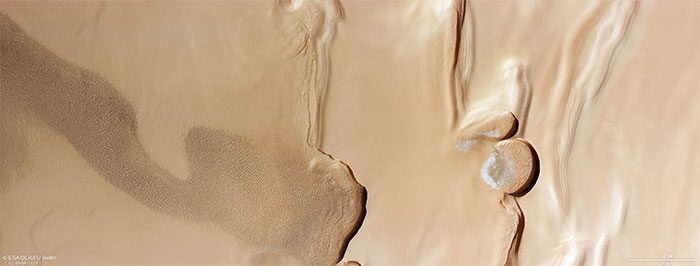New data from the Mars Express spacecraft not only unveils the “source of life” on Mars but also reveals a lost history of the planet.
According to Sci-News, images and other data obtained by Mars Express while flying over the northern polar region of Mars show that the polar ice cap here is a stack of water ice and dust layers up to 3 kilometers thick, with a diameter of about 1,000 kilometers.
These layers are divided into four thick layers stacked on top of one another, each varying in thickness, with each thick layer consisting of many thinner, finer layers.

Planum Boreum, an interesting area filled with water ice in the northern polar region of Mars – (Image: ESA).
Similar to tree rings that “tell stories,” these sediment layers contain information about the climate over millions of years on Mars.
Each sediment layer is a precipitation of dust and water from the atmosphere and results from direct frost formation. They consist mainly of ice, with fine dust sediments making up about 10 to 15% of the total amount.
According to the European Space Agency (ESA), the “owner” of the Mars Express orbiting Mars, the new data reflects changes in Mars’ orbit as well as the tilt of the planet’s rotation axis.
Our Earth occasionally changes its orbit slightly and tilts its rotation axis… However, Mars’ instability is even greater, potentially indicating that the climate of this world has undergone changes that are harsher than those on Earth.
As a result, changes in the rotation axis lead to variations in solar radiation across different points on the planet, particularly at the poles.
Currently, the northern polar ice cap is thriving. It will completely disappear during the summer.
“The terrain around the northern pole of Mars, known as Planum Boreum, is very intriguing” – the ESA team wrote.
In the image they just published, the left side is dominated by a vast, undulating dune belt, stretching over 150 kilometers within this frame.
This wrinkled, chaotic appearance is very contrasting to the flatter, more pristine terrain visible on the right side.
Meanwhile, the smooth area shows no clear signs of erosion and is not pockmarked by impact craters from space rocks, indicating that the surface is still very young and may even be rejuvenated annually.
“Between these two extremes are two crescent-shaped cliffs, the larger cliff is about 20 kilometers wide. Inside the concave part of these cliffs are frost-covered sand dunes.”
These are called polar troughs, a feature created when wind erodes the surface.
Not only is this data strange and fascinating, but the detailed information about an area with water ice is a “treasure” that Mars Express has sent back to Earth.
In the future, leading space agencies like NASA and ESA plan to establish a base on Mars. At that point, water ice will become a “source of life,” where they can find ways to convert it into drinking water and fuel.
Furthermore, the presence of water on another planet is essential for inferring whether that planet could support life.
With current scientific evidence, most scientists believe that Mars once harbored life billions of years ago when its climate was similar to Earth’s, before unfortunate planetary evolution made it harsher.
Moreover, some scientists still hope that some form of extreme life may still be hiding somewhere on this planet.




















































